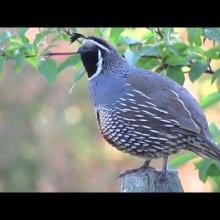

Join BirdNote tomorrow, November 30th!
Illustrator David Sibley and actor H. Jon Benjamin will face off in the bird illustration battle of the century during BirdNote's Year-end Celebration and Auction!
The most distinctive characteristic of the California Quail is the black, forward-facing topknot that juts out from its forehead like a small flag. The California Quail – the state bird of California – builds its nest right on the ground. Almost immediately after hatching, the precocial chicks are up and running, following their parents to feed.
BirdNote®
California Quail, Up and Running
Written by Frances Wood
This is BirdNote!
[“Cha-CA-go” call of California Quail]
Does this bird seem to be saying “cha-CA-go, cha-CA-go”? Don’t be misled—this small ground-bird, the California Quail, is strictly a bird of the far west.
[Repeat calls]
The California Quail’s gray and rusty-colored body is beautifully adorned. And the most distinctive characteristic of this quail is a black, forward-facing topknot that juts out from the bird’s forehead, like a small flag.
Although quail can fly short distances, they spend most of their time on the ground foraging for food. When they’re threatened, they scurry into thick brush.
Quail build their well-concealed nests right on the ground, which can hold from one to twenty-four eggs. Twenty four?! Yes, the large clutches may include eggs from more than one female. Immediately after hatching, the chicks follow their parents around the neighborhood, scratching for food. Two or more quail families may join together to form a covey of quail.
With such a large extended family, it’s not surprising when a male California Quail hops up on a stump to gather the covey together with this rallying call.
[More California Quail]
For Birdnote, I’m Mary McCann.
BirdNote's newsletter delivers the wonder and joy of birds directly to your inbox. Sign up at BirdNote dot org to get a weekly preview of our shows, stories, photos, and more.
###
Bird sounds provided by The Macaulay Library at the Cornell Lab of Ornithology, Ithaca, New York. Recorded by D.G. Allen.
Producer: John Kessler
Executive Producer: Chris Peterson
© 2012 Tune In to Nature.org June 2018 / May 2023
Narrator: Mary McCann
ID# 062105CAQUKPLU CAQU-01b-2009-06-20-MM




